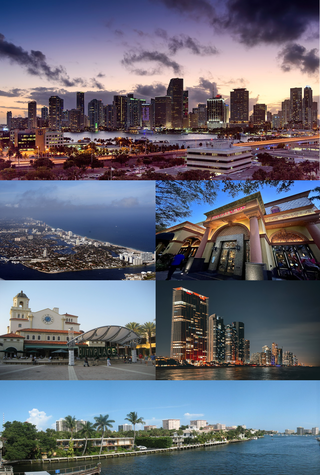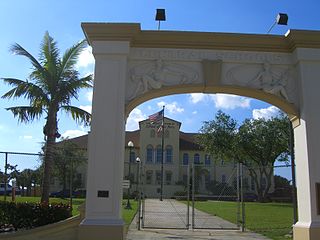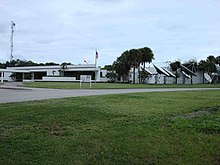
Palm Beach is an incorporated town in Palm Beach County, Florida, United States. Located on a barrier island in east-central Palm Beach County, the town is separated from West Palm Beach and Lake Worth Beach by the Intracoastal Waterway to its west and a small section of the Intracoastal Waterway and South Palm Beach to its south. It is part of the South Florida metropolitan area. As of the 2020 census, Palm Beach had a year-round population of 9,245.

The Miami metropolitan area is a coastal metropolitan area in southeastern Florida. It is the ninth-largest metropolitan statistical area (MSA) in the United States, the fifth-largest metropolitan area in the Southern United States, and the largest metropolitan area in Florida. It is also known as South Florida, SoFlo, SoFla, the Gold Coast, Southeast Florida, the Tri-County Area, or Greater Miami, and officially as the Miami–Fort Lauderdale–West Palm Beach Metropolitan Statistical Area. With a population of 6.18 million, its population exceeds 31 of the nation's 50 states as of 2023. It comprises the three most populated counties in the state, Miami-Dade County, Broward County, and Palm Beach County, which rank as the first, second, and third-most populous counties in the state, respectively. Miami-Dade County, with 2,701,767 people in 2020, is the seventh-most populous county in the United States.
WFOR-TV, branded CBS Miami, is a television station in Miami, Florida, United States. It is owned and operated by the CBS television network through its CBS News and Stations division alongside CW affiliate WBFS-TV. The two stations share studios on Northwest 18th Terrace in Doral; WFOR-TV's transmitter is located in Andover, Florida.
WBFS-TV is a television station in Miami, Florida, United States, affiliated with The CW. It is owned by the CBS News and Stations group alongside WFOR-TV, a CBS owned-and-operated station. The two stations share studios on Northwest 18th Terrace in Doral; WBFS-TV's transmitter is located in Andover, Florida.
WTVX is a television station licensed to Fort Pierce, Florida, United States, serving the West Palm Beach area as an affiliate of The CW. It is owned by Sinclair Broadcast Group alongside CBS affiliate WPEC and two low-power, Class A stations: MyNetworkTV affiliate WTCN-CD and TBD owned-and-operated station WWHB-CD. The stations share studios on Fairfield Drive in Mangonia Park ; WTVX's transmitter is located southwest of Palm City, Florida.

WTCN-CD is a low-power, Class A television station licensed to Palm Beach, Florida, United States, serving the West Palm Beach area as an affiliate of MyNetworkTV. It is owned by Sinclair Broadcast Group alongside CBS affiliate WPEC, CW affiliate WTVX, and Class A TBD owned-and-operated station WWHB-CD. The stations share studios on Fairfield Drive in Mangonia Park ; WTCN-CD's transmitter is located southwest of Hobe Sound, Florida.

Alexander W. Dreyfoos School of the Arts (DSOA) is a public high school in West Palm Beach, Florida. Formerly named the Palm Beach County School of the Arts, the school was renamed in recognition of a 1997 donation of $1 million by Alexander W. Dreyfoos, Jr., a West Palm Beach philanthropist. It is regularly ranked as one of the top public arts and academics schools in the country.
WWHB-CD is a low-power, Class A television station licensed to Stuart, Florida, United States, serving the West Palm Beach area with programming from the digital multicast network TBD. It is owned and operated by Sinclair Broadcast Group alongside CBS affiliate WPEC, CW affiliate WTVX, and Class A MyNetworkTV affiliate WTCN-CD. The stations share studios on Fairfield Drive in Mangonia Park, Florida, while WWHB-CD's transmitter is located southwest of Hobe Sound, Florida.

WTVJ is a television station in Miami, Florida, United States. It is owned and operated by the NBC television network through its NBC Owned Television Stations division alongside Fort Lauderdale–licensed WSCV, a flagship station of Telemundo. The two stations share studios on Southwest 27th Street in Miramar; WTVJ's transmitter is located in Andover, Florida.

WPTV-TV is a television station in West Palm Beach, Florida, United States, affiliated with NBC. It is owned by the E. W. Scripps Company alongside Stuart-licensed news-formatted independent station WHDT ; Scripps also provides certain services to Fox affiliate WFLX under a shared services agreement (SSA) with Gray Television. The stations share studios on South Australian Avenue in downtown West Palm Beach ; WPTV-TV's transmitter is located in Lake Worth along US 441/SR 7.

WPBF is a television station licensed to Tequesta, Florida, United States, serving the West Palm Beach area as an affiliate of ABC. Owned by Hearst Television, the station maintains studios on RCA Boulevard in the Monet section of Palm Beach Gardens and a transmitter in Palm City southwest of I-95.

WFLX, branded Fox 29, is a television station in West Palm Beach, Florida, United States, affiliated with the Fox network. It is owned by Gray Media, which maintains a shared services agreement (SSA) with the E. W. Scripps Company, owner of NBC affiliate WPTV-TV and Stuart-licensed news-formatted independent station WHDT, for the provision of certain services. The stations share studios on South Australian Avenue in downtown West Palm Beach ; WFLX's transmitter is located near Wellington west of US 441/SR 7.
WXEL-TV is a PBS member television station licensed to Boynton Beach, Florida, United States, serving the West Palm Beach area. Owned by South Florida PBS, it is a sister station to Miami-based flagship and fellow PBS member WPBT and low-power station WURH-LD. The three stations share transmitter facilities on Northwest 199th Street in Andover; WXEL's studios are located on South Congress Avenue in Boynton Beach. WXEL, WPBT, and WURH-LD are also broadcast by a translator in Fort Pierce.

WHDT is an independent television station licensed to Stuart, Florida, United States, serving the West Palm Beach area. It is owned by the E. W. Scripps Company alongside NBC affiliate WPTV-TV ; Scripps also provides certain services to Fox affiliate WFLX under a shared services agreement (SSA) with Gray Television. The stations share studios on South Australian Avenue in downtown West Palm Beach ; WHDT's transmitter is located near Wellington west of US 441/SR 7.
WTCE-TV is a religious television station licensed to Fort Pierce, Florida, United States, serving as the West Palm Beach–area outlet for the Trinity Broadcasting Network (TBN). It is owned and operated by TBN's Community Educational Television subsidiary, which manages stations in Florida and Texas on channels allocated for non-commercial educational broadcasting. WTCE-TV broadcasts from a transmitter in unincorporated southeastern Martin County.
WBEC-TV is an educational television station owned and operated by Broward County Public Schools, licensed to Boca Raton, Florida, United States. WBEC-TV broadcasts from studios in Davie and a transmitter in Pembroke Park; the school district also owns WKPX, a non-commercial radio station. Although the station is based in Broward County, WBEC-TV's city of license, Boca Raton, is located within Palm Beach County.

WOLL is a commercial FM radio station licensed to Hobe Sound, Florida. The station is owned by iHeartMedia, Inc., and airs an adult contemporary radio format. WOLL serves Florida's Treasure Coast and the Palm Beaches. Sunday through Friday evenings, it carries the syndicated Delilah show featuring call-ins and dedications, provided by co-owned Premiere Networks.
Alexander Wallace Dreyfoos Jr. was an American businessman and philanthropist based in West Palm Beach, Florida, and Saranac Lake, New York.
WIRK-TV, UHF analog channel 21, was a television station licensed to West Palm Beach, Florida, United States. It was the first television station in the Palm Beach area, signing on September 13, 1953. However, it was quickly overshadowed by new VHF stations, which took away its network affiliations, and ceased telecasting February 29, 1956.
On January 1, 1989, six television stations in the Miami–Fort Lauderdale and West Palm Beach, Florida, markets, exchanged network affiliations. The event, referred to in contemporary media coverage as "The Big Switch", was described as "Miami's own soap opera" and at times compared to Dallas and Dynasty because of the lengthy public disputes between multiple parties that preceded it. Approximately three million television viewers in both markets were affected.











